Centenary Radio – Serendipity in the South – The WBT Story
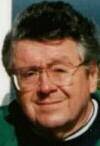
(There is an old Persian fairy tale concerning some men sent on a mission. The Three Princes of Serendip (modern-day Sri Lanka) kept finding things seemingly unneeded or unknown at the outset but ultimately found to be useful. The word serendipity, an aptitude for making desirable discoveries by accident, was coined in 1754 by English author Horace Walpole.)
It must have been from serendipity. How else could you explain the growth of WBT, Charlotte, NC, from an amateur radio hobby in 1912 to one of the “Grande Dames” of today’s radio stations?
HUMBLE ROOTS
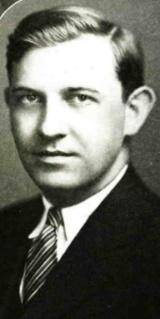 |
By his own account, the first of WBT’s three founders, Earle Gluck, obtained his Federal “Wireless Operator” license at Baltimore in 1912 and an “Amateur Station” license there in 1914. |
However, World War I, though, caused the silencing of all non-government radio operations, whereupon Gluck took his skills to sea with the U.S. Navy.
After the war, Gluck gained employment with Southern Bell Telephone in Charlotte. One day in late 1920 he went shopping in a Charlotte electrical store for materials to rebuild his amateur station. There, he happened upon two others with similar interests. One was an engineer at Westinghouse Electric and Manufacturing, Frank Bunker. The other was Fred Laxton, of the electrical contracting firm Tucker and Laxton in Charlotte. The three soon became fast friends.
From his previous employment at General Electric, Laxton knew of some (for the time) “high powered” vacuum tubes under development at GE that could drive a radiotelephone transmitter. The notion of being able to communicate with other hams by voice rather than telegraph appealed to the three when Laxton said he thought he could get a pair of the new tubes through his GE connections.
4XD GOES ON THE AIR
In short order the trio had assembled a transmitter in an abandoned chicken coop behind Laxton’s house on Mecklenburg Avenue in Charlotte, across from the Charlotte Country Club.
Their test receiver and microphone were located in the comfort of the house. With the technology of the day, one easily can imagine that careful watching was needed to avoid damage to the precious tubes.
A few months later, in March 1921, the balky apparatus had been sufficiently tamed to secure a station license for Experimental Station 4XD. It reported in the Radio Service Bulletin in June 1921.

LET’S HAVE SOME MUSIC!
According to Gluck, as the junior partner he had to stay in the house to talk on the microphone while the others went outside to observe the fantastic new hardware in operation.
Gluck soon struck on the notion of playing a record on the phonograph with the microphone placed in front of it. Thus, he could at least get a glimpse of the transmitter for several minutes at a time.
Even though there were few transmitters or receivers in early 1921, it did not take long for Laxton’s phone to begin ringing with calls from people who had built receivers and were pleasantly amazed to hear music in their earphones. In fact, the trio realized they could create a going business selling the components, supplies and instructions for home building radio receivers, since no complete receivers were being sold in the Charlotte market at the time.
THE SOUTHERN RADIO CORPORATION
Soon, the Southern Radio Corporation set up on the eighth floor of the Independence Building in “uptown” Charlotte.
For the sake of business efficiency, the three moved the 4XD transmitter to the roof of the Independence Building and there gave it a fan-shaped transmitting antenna dangling down the face of the building.
FROM 4XD TO WBT
Gluck had by this time been routinely assigned duty as a “combo man,” operating the transmitter, making announcements, and playing the records for music.
He continued to be dogged by colleagues for the balance of his career about his beginnings as the “talent.” In doing so, he also started a long-standing tradition of WBT having “combo men.”
In January 1922, the Commerce Department formally established the broadcast service; Gluck and company applied for one of the first such licenses. So it was that on Monday, April 10, 1922, former Experimental Station 4XD changed its radiated identity to WBT. Nevertheless, one could say that, like many others around the nation, WBT had started licensed operations even earlier – as early as March 1921.
Operating on 360 meters, WBT published an operating schedule of 10:00 to 11:45 AM and 7:30 to 9:45 PM daily. In later years, Gluck admitted that operations in the early days were often “spasmodic,” as he found it difficult to find adequate material to fill the schedule.
FILLING THE SCHEDULE
That situation did not last long. Soon, performers who were to become household names across the nation began to appear on WBT.
Among these were bandleader Hal Kemp, and Freeman Gosden and Charlie Correll, headlined as “Two Black Crows.” The duo would later move to Chicago and broadcast nationwide for many years as “Amos ‘n Andy.”
Another future famous Big Band leader, John Scott Trotter, appeared on WBT. Trotter was later to spend years in close association with Bing Crosby as Crosby’s band leader on nationwide broadcasts.
NEW OWNER, NEW HOME, NEW SLOGAN
In 1927, the three friends decided it was time to liquidate their interests in Southern Radio Corporation, so they sold the receiver sales business (by then an RCA distributorship) to the Carolina States Electric Company and WBT to Charlotte’s Buick dealer, C. C. Coddington. Gluck stayed on with his radio baby.
Coddington’s ownership signaled the start of quite benevolent ownership of WBT. At the outset, the WBT “home brew” transmitter and studio was installed in a penthouse atop the Coddington Building, with two new 80-foot towers to support an improved transmitting antenna. Office space was provided below on the third floor.
In fact, WBT now was beginning to look like a standalone radio station business rather than a sales adjunct to a parts supply house. Fitting its status, Coddington’s sales manager, Lee Folger, displayed company pride in the radio station by applying the logo, “Watch Buick Travel” to the stations’ call sign.
GROWING THE SIGNAL
Under Coddington ownership, Gluck was able to secure affiliation with the new National Broadcasting Company’s networks, thus WBT now had a steady supply of program material from among the famously known national network programs of the day.
The “home brew” transmitter that was rated at 250 Watts got beefed up to 500 Watts and, in early 1928, Coddington purchased a Western Electric 106-A transmitter that could operate at 1,000 Watts. Within months, Coddington planned to procure a 5,000 Watt transmitter from General Electric and move the WBT location to his farm, seven miles south of “uptown.”
On Coddington’s farm, WBT would get a fine new transmitter building and a triatic wire transmitting antenna suspended between two used 250-foot windmill towers spaced 600 feet apart in a cotton field.
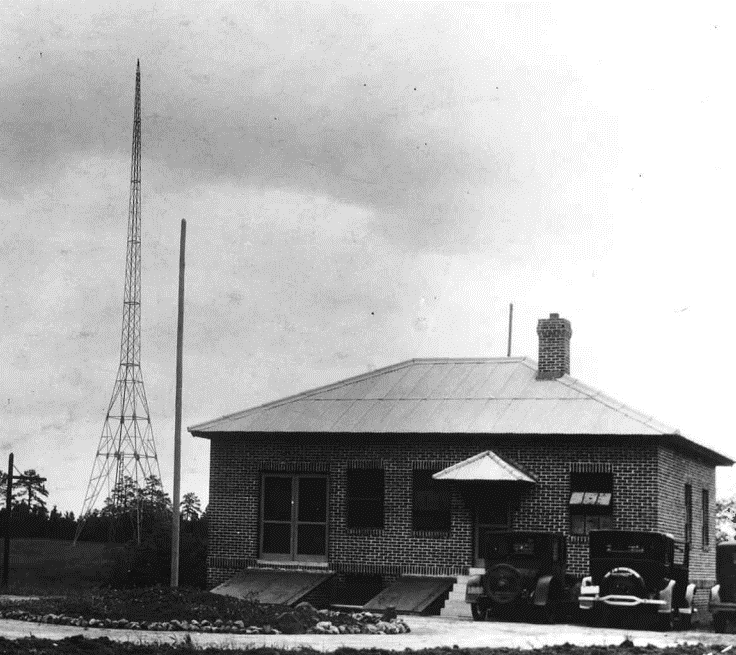
A larger transmitter building was constructed in 1933.
That site, along Nations Ford Road of Charlotte, has been the home of WBT’s AM transmitters ever since.
GROWING TOWERS, GROUNDS, STAFF
The antenna had a proper ground plane of 47 radial wires planted in trenches two feet deep to avoid damage from the cotton farming on the field.
During this expansion phase, Coddington increased the WBT staff considerably with a Station Manager, an audio supervisor and several control engineers. Gluck was made Chief Engineer.
Curiously, despite many modern conveniences at the new transmitter site (like a Kelvinator electric refrigerator, a toaster, a percolator and a waffle iron), the site had no telephone. In its place, Gluck’s amateur station W4CQ and a new one, W4AJJ, were operated as a link to the city.
A PAUSE FOR THE WEATHER
The expanded capital plan also included all new studio and audio equipment from RCA. For example, two superb new condenser microphones arrived, permitting even better quality audio originations at WBT. Such microphones cost $400 each in 1928 (about $7,000 in 2022 money).
Completion was planned for September 1928, just about a year after the Coddington acquisition. Sale of the used WBT apparatus, right down to its towers, was arranged with a Florida buyer. Unfortunately, manufacturing delays at General Electric combined with heavy rains and a hurricane in the Southeast slowed the transmitter site project.
WBT moved to support the communities during the emergency. With telephone facilities in much of Florida and Georgia down, WBT used the amateur operation to get news from the outside world; for example, relaying news of Charlotte students stranded in Charleston by the storm. Famed entertainer Jimmy Rodgers came to Charlotte to broadcast an appeal for hurricane relief donations. Rodgers raised $3,100 (2007 equivalent: over $35,000) in one short program.
COMPLETING THE PROJECT
Finally, on October 1, 1928 the new transmitter building had been roofed and major parts of the General Electric 5,000 Watt transmitter began to arrive – unfortunately with some damage in transit. Meanwhile, WBT obtained permission from the Federal Radio Commission to radiate up to 10,000 Watts.
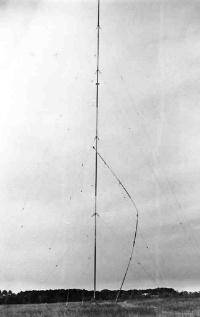
Then, as the tower riggers were just finishing up at the transmitter site, they pulled the antenna wire too tight, causing the top 35 feet of one of the towers to fold ever.
There was more delay waiting for replacements as well as items in short supply, like lead-sheathed, twisted-pair wire for audio wiring.
Finally, on November 19, 1928, the last needed items were received from General Electric and a short test commenced at 1:00 AM. With high anticipation, the first airing of the new 5,000 Watt transmitter was planned for 10:30 PM the following evening, November 21st.
ELATION AND SADNESS
Operating first at just 2,500 Watts, WBT got excellent reception reports from 38 states and several Canadian provinces.
The signal must have boomed in to Rhode Island, as 20 telegram reports came from Providence alone, while other Rhode Island locations added 50 more telegrams to the stack. At 1:00 AM, full 5,000 Watt operation began and continued thereafter, starting a WBT tradition of having a skywave audience every night.
By the end of the month, the new 5,000 Watt transmitter was deemed sufficiently reliable to permit disconnection of the Western Electric 106-A in town and shipment to its new Florida owner.
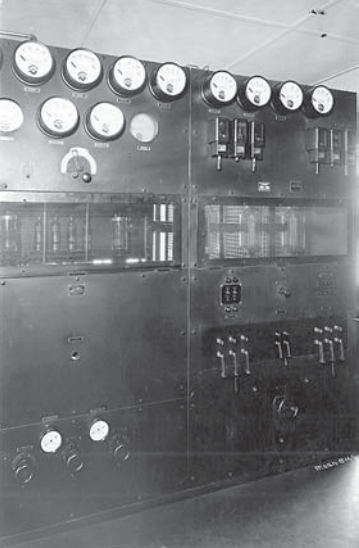
Regrettably, on December 3 – just weeks after seeing his proud new WBT on the air – C. C. Coddington suddenly dropped dead from a heart attack at the age of just 50. On the same date, WBT was reported having been received in the Hawaiian Islands, about 5,500 miles distant.
Quite an odyssey of happenings, it is almost hard to believe it was just eight years from the inception of 4XD as a fun project for three young men.
But a new era for WBT was about to begin.
THE BEANCOUNTERS ARRIVE
With Coddington’s death, control of WBT reverted to the executor of his estate, Union National Bank.
A lull occurred for a few months as the bank controllers took over the business. The station had been a healthy business, but the bankers made quite a bit more profitable, increasing airtime hours and profits considerably. One note from early December 1928 indicates that the cost of network lines had been eliminated, along with the NBC affiliation.
In September 1929, WBT was financially healthy and even had its own 10-piece studio orchestra, while still carrying the nightly theatre organ recitals. There was plenty of musical fare being broadcast from Charlotte on WBT.
Around this time, Earle Gluck seems to have dropped out of the WBT picture. However, he was back in the Charlotte radio picture with the establishment of competing WSOC in 1931, along with other former WBT staffers.
A NEW FAMILY
During 1929, the bank arranged sale of WBT to a holding agent company affiliated with CBS, from which a long relation with CBS, first as an “O and O” (Owned and Operated) until 1945, and under later owners as a network affiliate.
With CBS, WBT joined an august family of radio stations that included such fabled call signs as WCBS, KNX, KMOX, KCBS, WBBM, WTOP and WCCO to name a few. CBS was at the time, a most aggressive business in both technology and programming, having hired many famous early radio entertainers away from NBC.
WBT now enjoyed carrying such audience draws as Bing Crosby, Al Jolson, George Burns and Gracie Allen, and Kate Smith.
MORE POWER
After its purchase by CBS, WBT got a hefty transmitter power increase in 1931 to 25,000 Watts.
The records are vacant on the reason for a power level of 25,000 Watts, but the installation of a Blaw-Know “diamond” tower and a further power increase to 50,000 Watts in 1933 suggests the triatic wire antenna for the 5,000 Watt transmitter was simply unworkable with the high Voltages and currents of 50,000 Watt operation.
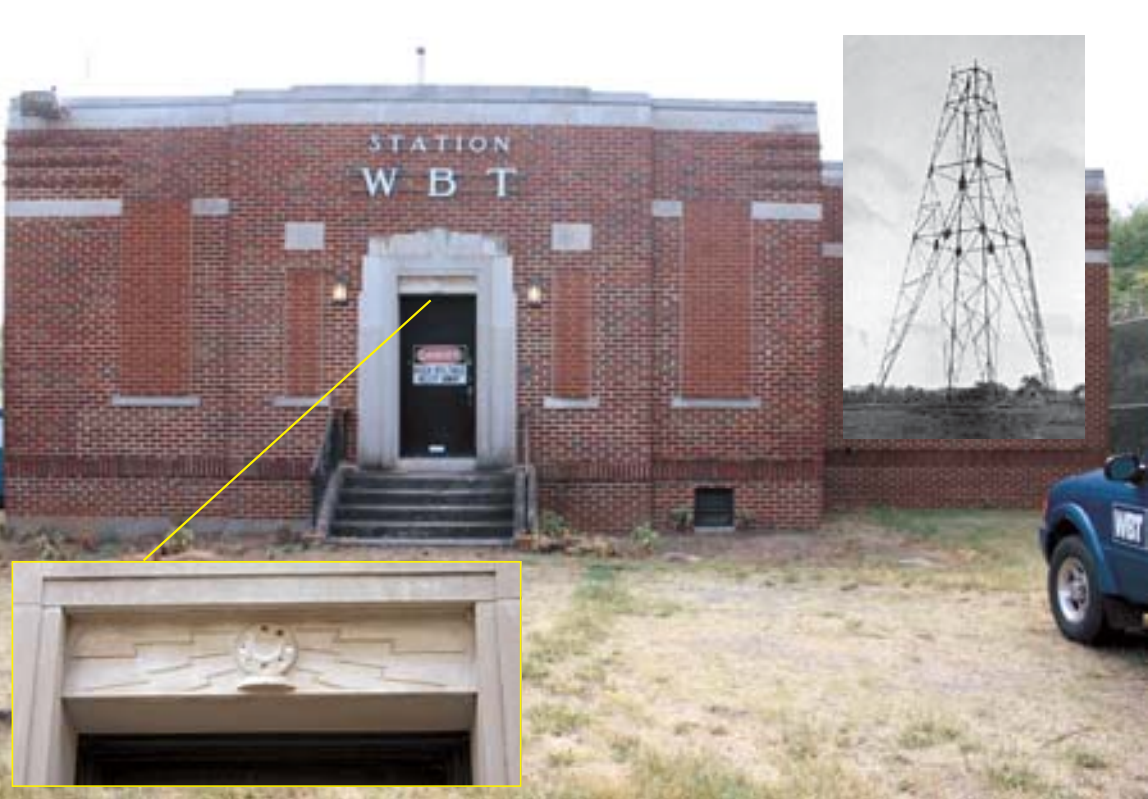
The 50 kilowatt WBT AM signal grew to international prominence, being one of the American stations regularly heard across the Atlantic Ocean and listed in aeronautical publications as a reliable radio direction-finding signal for air pilots. By 1940, the WBT AM transmitter site with its distinctive Blaw-Knox “diamond” tower was listed on air navigation charts not only as a landmark, but as a guide for landing at nearby Charlotte Douglas Airport.
LOCAL RADIO WITH A NATIONAL IMPACT
The autumn of 1930 witnessed the first noon news readings by well-known Charlotte radio personality Grady Cole.
Cole’s career at WBT was to last until 1961, an almost unheard of span of 31 years for a single “morning man,” including later years as an early days “combo man” doing the morning show from the WBT transmitter site.
In 1933, another long-time Charlotte radio luminary, Charles Crutchfield, joined the staff. Many well-known programming aspects of WBT’s on-air “southern personality” owe their aegis to Charles Crutchfield.
As a CBS “O&O,” WBT became a sort of “farm club” for the CBS radio network. Andy Griffith applied at WBT in 1941, but was rejected because he expected a salary of $75 (which would be more than $1,500 today) per week. The Carter family sang on WBT, including young June who would later become country luminary June Carter Cash. (Surprisingly, Charlotte-bred Charles Kuralt, one of CBS Radio’s all-time luminaries, grew up writing for Charlotte newspapers but never broadcast his mellifluous voice on WBT until after his employment by the network.)
Federal ownership constraints enacted after WWII required CBS to sell WBT in 1945. Jefferson-Pilot Insurance bought the property for $1,505,000 (2022 equivalent: $29.6 million).
EMERGENCY RESOURCE
With WWII looming in 1941, the FCC made WBT a “key station,” to function as a communication source and center for about 25 other stations in event of national emergency. This became a root of the later Conelrad system.
Later in WBT’s Conelrad career, a small control room was built below ground level into the second sub-basement of the WBT transmitter building, complete with Cold War style survival fittings, in an effort to make WBT-AM the most survivable of radio stations.
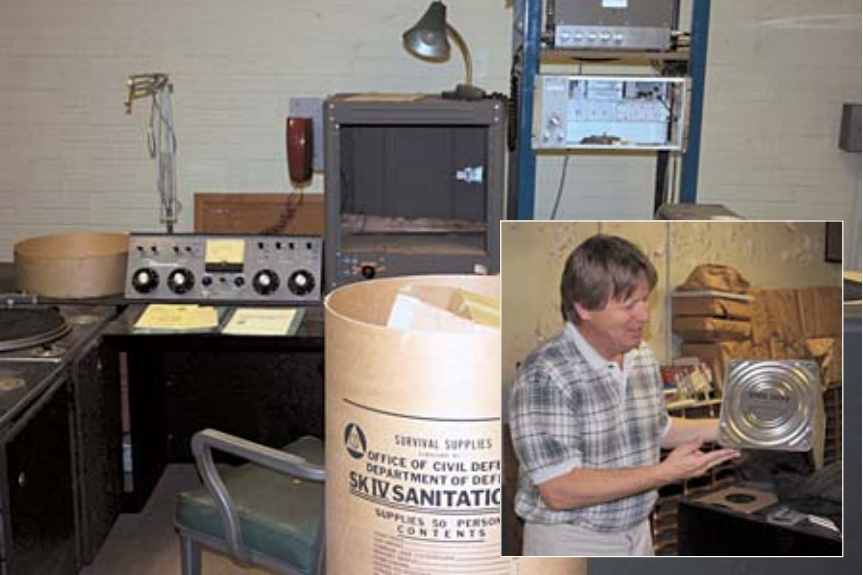
“stocked” with supplies into the 21st century
During WWII, it was discovered that German U-Boats favored WBT as a navigational aid, so to aid the US war effort; WBT broadcast false news items to mislead U-Boat listeners about the status of the United States homeland.
In the later “Cold War” Era, WBT changed its overnight programming to a locally produced “Radio Moscow,” intended to counteract the Soviet propaganda being sent to the US by Russia. “Radio Moscow” ultimately grew to syndication on 26 stations, and was subsumed by “Radio Liberty”
Evidence that it aggravated Castro and the Soviets was seen in the extensive jamming attempted against WBT from Cuba.
MULTIPLYING TOWERS
Like a number of other conflicts that resulted from the 1941 NARBA changes, WBT encountered objection to its nighttime skywave from KFAB, Omaha NE, which was moved from 780 to 1110 by the NARBA treaty.
For some years, WBT operated on STA’s while seeking a solution to the KFAB problem.
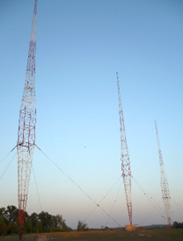 |
A first effort toward reducing WBT’s radia-tion toward KFAB was a directional antenna, (DA) made of three towers. They are still there, today – three of the eight Blaw-Knox towers still operating in the US – a well-known visual feature of Charlotte, seen by travelers on I-77, with a flashing white strobes at night. |
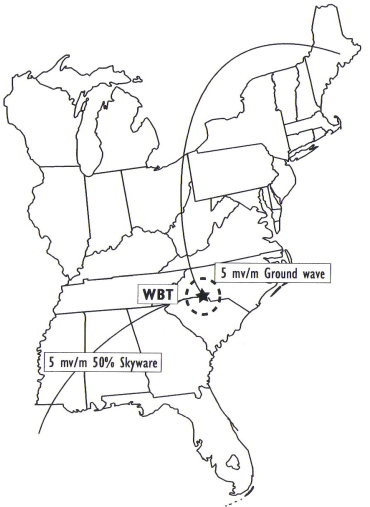 |
The DA caused a big loss of night-time signal to the west – particularly toward Shelby, NC and westward. WBT’s QSL card showed a sharp notch in its nighttime 0.5 mV/m skywave contour.
Trying to solve this, WBT’s engineers built a 1 kW synchronous repeater in 1946 at Shelby NC, backfilling the null toward KFAB. Unfortunately, this combination still did not settle the KFAB matter.
ADJUSTING SKYWAVE
A small skywave lobe is a well-known characteristic of the “diamonds,” dating back at least to observations in the 1930s by RCA’s doyen of directionals, George H. Brown.
His engineering purist view (perhaps also encouraged by the fact that the “diamonds” were sold by his employer’s arch rival, Western Electric) was that skywave lobe is wasted power lost from local groundwave coverage.
However, as WBT’s loyal evening skywave audience shows, WBT turned an apparent flaw into a feature, As some in the South would say, WBT “made lemonade out of a lemon.” WBT’s nighttime skywave signal in fact, was an audience asset rather than a liability, garnering listener responses all the way from Canada to Cuba. Over the years, WBT evening personalities have played to a surprisingly loyal skywave audience.
Still, WBT continued to address the KFAB conflict. Rather than make surgical changes to its steel as WSM had done in a similar situation, WBT’s engineers placed an elevated ground screen around its tower bases to modify the vertical radiation characteristics of the Blaw-Know diamond towers.
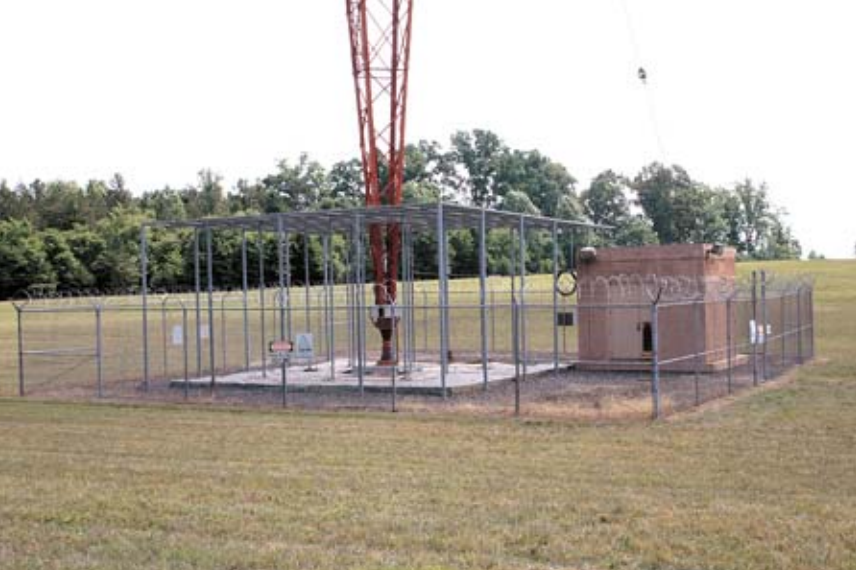
This change did reduce WBT’s skywave toward KFAB, but only momentarily. At the very time of completing a whole new AM-DA Proof of Performance that included the effect of some 16 cellular and two-way towers in its near field, the WBT engineers discovered a new 17th tower, necessitating further adjustments and a new complete proof to finally get back on direct power measurement.
Today’s operators should be grateful for a later Rulemaking that protects AM operators from the effects of others in their near field!

RECOVERING AGAIN FROM WEATHER
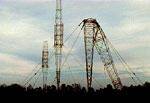
As it turned out, not that many years after finally achieving a stable state for the WBT DA, disaster struck in the form of Hurricane Hugo in late September 1989.
Two of the three Blaw-Knox “diamonds” were destroyed by the hurricane.
In order to restore that stable DA state, it was necessary to get two new towers built exactly as the originals, and that meant reconstructing manufacturing drawings and work, which process took several years. As an indication of the high regard WBT commands in the broadcasting world, the FCC authorized non-directional operation unlimited at full power during the long repair process. Few stations might expect such a relaxation of license parameters.
As part of this final settlement of the KFAB issue, WBT shut down the Shelby synchronous repeater and added an FM translator at Chester, SC to provide WBT programming to the area.
INTO THE NEW CENTURY
As many stations have, WBT has upgraded over the years.
After the Western Electric, an RCA 50B, and RCA BTA-50F1, and an MW50A served for a number of years, until the Harris 3DX50 Destiny came on line. The WBT signal is solid.
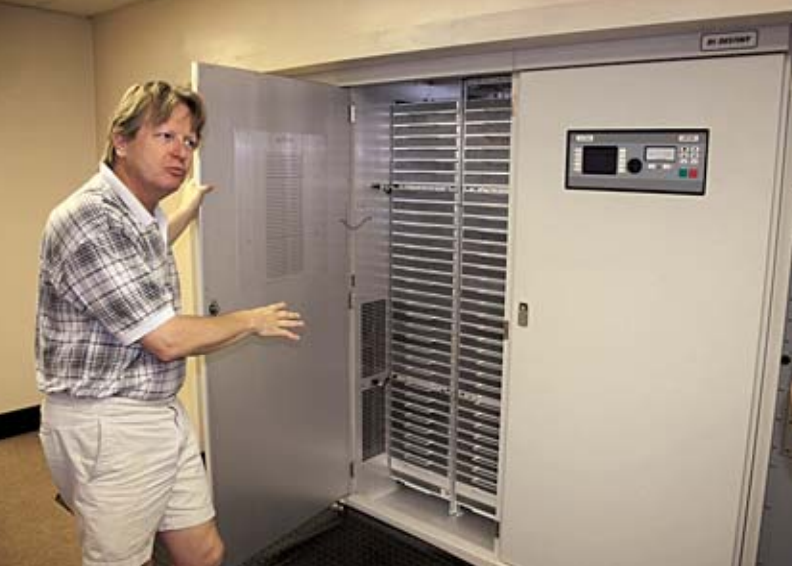
WBT’s 50 kW Harris Destiny transmitter during the author’s visit in 2007
In August of 2013, WBT became one of the first to test out all-digital HD Radio programming on AM. Interestingly, the tests were conducted at night, providing reports of digital reception from Florida to Massachusetts. Although WBT stopped all-digital transmission, its pioneer work led, over the next six or seven years, to where we now have three fulltime digital stations in the US.
CH-CH-CHANGES
In late 1979, WBT started a format drift from mostly music to talk shows. By the time Rush Limbaugh’s program was added in 1991, WBT was officially News/Talk.
Other changes have occurred during the last 16 years, which have seen WBT under several changing ownerships.
In 2006 Lincoln Financial Group bought and merged Jefferson-Pilot, giving WBT a new ownership identity. Then, in 2008 Lincoln Financial sold WBT to Greater Media, which merged into the Beasley Media Group in 2017. Beasley had too many stations in Charlotte, so they spun WBT to Entercom.
Finally, in 2021 Urban One swapped a group of stations with Entercom and received the Charlotte stations including WBT. The current format is a News/Talk format.
Transmission has also changed with WBT using an FM and an HD2 signal. And, not to be left behind by changes in communications technology, WBT’s News/Talk is also streamed to the Internet at www.wbt.com.
COMMUNITY RESOURCE
From 1927 hurricane coverage, to WWII propaganda through the Cold War to Vietnam, and natural disasters since, WBT and its air staff have been good public citizens of the first order.
All the while, WBT has drawn top ratings for its programs and its air staff right through the Big Band, radio drama and soap opera, Top 40, and Talk Radio eras.
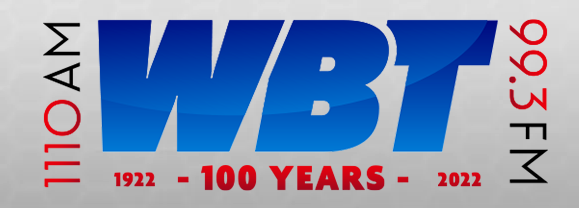
For the past century, it has truly been a serendipitous journey for WBT and its audience.
– – –
Don Kimberlin’s career ranged from engineering local stations to the video circuits for the Moon Landing.
Your address is never given out to anyone.
– – –
